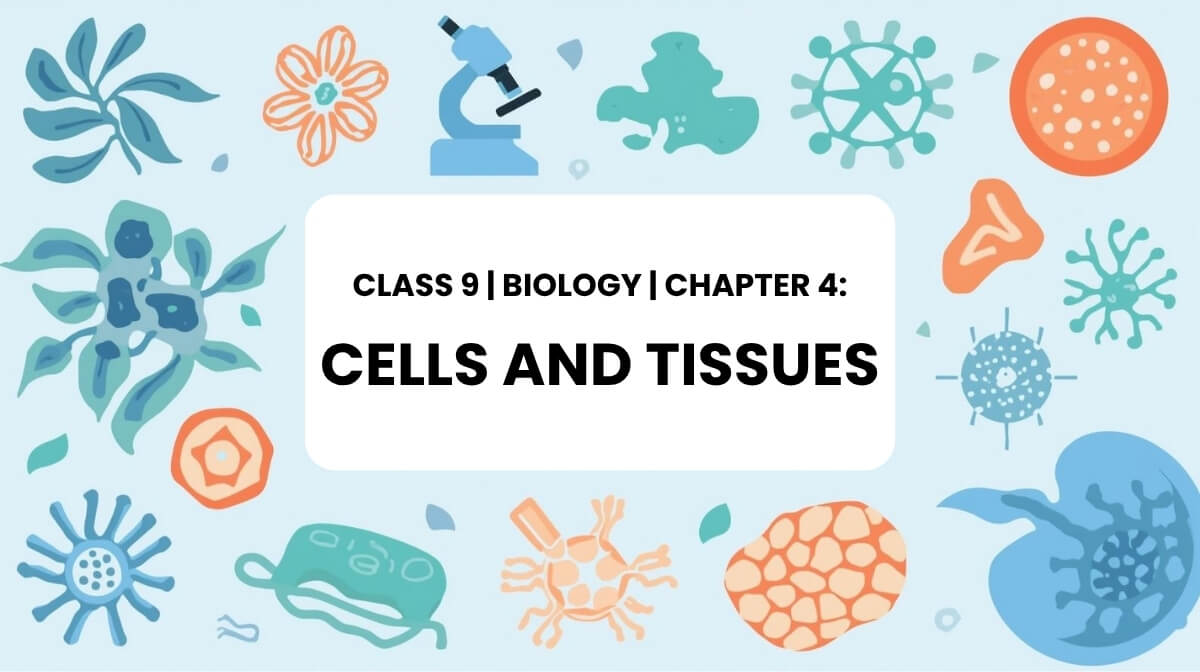This chapter explains the fundamental building blocks of all living things. This post provides Class 9 Biology Chapter 4 MCQs to help students test their understanding of cell structure, functions, and types of tissues in plants and animals. Topics covered include cell organelles, microscopy, differences between plant and animal cells, and the major tissues that make up organisms.
1. Who discovered the cell while observing a cork under a microscope?
- A. Anton van Leeuwenhoek
- B. Matthias Schleiden
- C. Robert Hooke ✅
- D. Rudolf Virchow
Explanation: Robert Hooke discovered cells in 1665 while examining cork tissue under a microscope.
2. Which instrument is used to observe the internal structures of a cell?
- A. Light microscope
- B. Electron microscope ✅
- C. Hand lens
- D. Telescope
Explanation: Electron microscopes provide high magnification and resolution to see detailed cell structures.
3. What is the jelly-like substance inside the cell that contains organelles?
- A. Nucleus
- B. Vacuole
- C. Cytoplasm ✅
- D. Mitochondria
Explanation: Cytoplasm is the fluid part of the cell where organelles are suspended and many reactions occur.
4. Which part of the cell controls its activities?
- A. Cell wall
- B. Cytoplasm
- C. Nucleus ✅
- D. Ribosome
Explanation: The nucleus contains DNA and regulates all cell functions including growth and reproduction.
5. What is the main difference between plant and animal cells?
- A. Animal cells have chloroplasts
- B. Plant cells have a cell wall ✅
- C. Both lack nuclei
- D. Plant cells lack mitochondria
Explanation: Unlike animal cells, plant cells have a rigid cell wall made of cellulose for support.
6. Which organelle is known as the “powerhouse of the cell”?
- A. Chloroplast
- B. Ribosome
- C. Mitochondria ✅
- D. Lysosome
Explanation: Mitochondria generate energy by breaking down glucose in the form of ATP.
7. Which type of tissue in animals helps in movement?
- A. Nervous tissue
- B. Muscular tissue ✅
- C. Epithelial tissue
- D. Connective tissue
Explanation: Muscular tissues contract and relax to help in movement of body parts.
8. Xylem in plants is responsible for:
- A. Transporting food
- B. Transporting water ✅
- C. Photosynthesis
- D. Reproduction
Explanation: Xylem conducts water and minerals from roots to the rest of the plant.
9. Which organelle is involved in protein synthesis?
- A. Lysosome
- B. Ribosome ✅
- C. Golgi body
- D. Vacuole
Explanation: Ribosomes build proteins by joining amino acids according to the genetic code.
10. Which of the following tissues is found in plants?
- A. Epithelial tissue
- B. Parenchyma ✅
- C. Cartilage
- D. Muscle tissue
Explanation: Parenchyma is a simple permanent plant tissue involved in storage and photosynthesis.
11. Which part of the microscope is used to focus the image?
- A. Objective lens
- B. Fine adjustment knob ✅
- C. Mirror
- D. Eyepiece
Explanation: The fine adjustment knob helps bring the specimen into sharp focus under high power.
12. Which cell organelle is responsible for photosynthesis?
- A. Mitochondria
- B. Chloroplast ✅
- C. Golgi apparatus
- D. Nucleus
Explanation: Chloroplasts contain chlorophyll and are the site of photosynthesis in plant cells.
13. Which scientist proposed that all plants are made of cells?
- A. Theodor Schwann
- B. Matthias Schleiden ✅
- C. Robert Brown
- D. Virchow
Explanation: Schleiden stated that all plant tissues are composed of cells, contributing to cell theory.
14. What is the function of vacuole in plant cells?
- A. Photosynthesis
- B. Storage and maintaining turgor ✅
- C. Protein synthesis
- D. Cellular respiration
Explanation: The vacuole stores nutrients and water, and helps maintain internal pressure (turgor).
15. Which animal tissue connects bones to muscles?
- A. Cartilage
- B. Tendons ✅
- C. Ligaments
- D. Nervous tissue
Explanation: Tendons are strong connective tissues that attach muscles to bones.
16. Which statement is part of the cell theory?
- A. Cells do not arise from other cells
- B. All living things are made up of cells ✅
- C. Cells are only in plants
- D. Only animals have cells
Explanation: One core principle of cell theory is that all organisms are composed of one or more cells.
17. What type of tissue lines the inner surfaces of organs?
- A. Epithelial tissue ✅
- B. Muscular tissue
- C. Connective tissue
- D. Nervous tissue
Explanation: Epithelial tissue forms protective layers over organs and body cavities.
18. Which organelle modifies and packages proteins?
- A. Ribosome
- B. Nucleolus
- C. Golgi apparatus ✅
- D. Lysosome
Explanation: The Golgi apparatus processes proteins made by ribosomes and sends them to their destinations.

